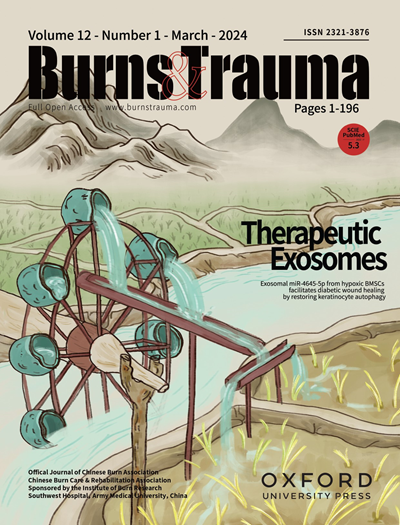疤痕年龄、激光类型和激光治疗间隔对儿科烧伤疤痕的影响:系统回顾和荟萃分析
IF 6.3
1区 医学
Q1 DERMATOLOGY
引用次数: 0
摘要
背景 激光疗法在治疗小儿烧伤疤痕方面发挥了重要作用;然而,文献中的研究结果却不尽相同,尤其是在开始激光治疗的最佳时机方面。本研究旨在通过对以往研究进行荟萃分析,探讨疤痕年龄、激光类型和激光治疗间隔等因素对儿童烧伤疤痕治疗效果的影响。方法 2022年5月,我们在7个数据库中进行了文献检索,通过对激光干预前后的标准化平均差(SMD)进行荟萃分析,了解激光治疗对儿童烧伤疤痕疗效的影响。荟萃分析使用 4.0 版综合荟萃分析软件进行。无明显异质性时选择固定模型,发现明显异质性时选择随机效应模型进行分析。在所有分析中,P 值为 < 0.05 即为显著。结果 七项研究被纳入荟萃分析,共有 467 名患者参与。激光疗法明显改善了烧伤疤痕的温哥华疤痕量表(VSS)/患者和观察者疤痕评估总量表(Total POSAS)、血管性、柔韧性、色素沉着和疤痕高度。研究之间存在显著的异质性,因此进行了分组分析。与潜伏疗法(伤后 12 个月)相比,早期激光疗法(伤后 12 个月)能显著改善 VSS/POSAS 评分 {SMD -1.97 [95% 置信区间 (CI) = -3.08; -0.87],p<0.001 vs -0.59 [95%CI = -1.10; -0.07],p = 0.03}以及血管性{SMD -3.95 [95%CI = -4.38; -3.53],p<0.001 vs -0.48 [95%CI = -0.66; -0.30],p<0.001}。与烧蚀、脉冲染料激光以及烧蚀和脉冲染料激光联合治疗相比,非烧蚀激光最有效,能显著降低VSS/POSAS、血管性、柔韧性和疤痕高度。与 4 至 6 周的治疗间隔相比,更短的治疗间隔(<4 周)可显著降低 VSS/POSAS 和疤痕高度。结论 儿童激光治疗的疗效受疤痕年龄、激光类型和激光治疗间隔时间的影响。这项研究的结果尤其对目前公认的激光治疗开始时间提出了挑战。研究中观察到了显著的异质性,这表明有必要探索影响激光治疗后烧伤疤痕疗效的其他干扰因素。本文章由计算机程序翻译,如有差异,请以英文原文为准。
Influence of scar age, laser type and laser treatment intervals on paediatric burn scars: a systematic review and meta-analysis
Background Laser therapy has emerged to play a valuable role in the treatment of paediatric burn scars; however, there is heterogeneity in the literature, particularly concerning optimal timing for initiation of laser therapy. This study aims to investigate the effect of factors such as scar age, type of laser and laser treatment interval on burn scar outcomes in children by meta-analysis of previous studies. Methods A literature search was conducted across seven databases in May 2022 to understand the effects of laser therapy on burn scar outcomes in paediatric patients by metanalysis of standardized mean difference (SMD) between pre- and post-laser intervention. Meta-analyses were performed using the Comprehensive Meta-Analysis software version 4.0. Fixed models were selected when there was no significant heterogeneity, and the random effects model was selected for analysis when significant heterogeneity was identified. For all analyses, a p-value < 0.05 was considered significant. Results Seven studies were included in the meta-analysis with a total of 467 patients. Laser therapy significantly improved Vancouver Scar Scale (VSS)/Total Patient and Observer Scar Assessment Scale (Total POSAS), vascularity, pliability, pigmentation and scar height of burn scars. Significant heterogeneity was found between the studies and thus subgroup analyses were performed. Early laser therapy (<12 months post-injury) significantly improved VSS/POSAS scores compared to latent therapy (>12 months post-injury) {SMD −1.97 [95% confidence interval (CI) = −3.08; −0.87], p < 0.001 vs −0.59 [95%CI = −1.10; −0.07], p = 0.03} as well as vascularity {SMD −3.95 [95%CI = −4.38; −3.53], p < 0.001 vs −0.48 [95%CI = −0.66; −0.30], p < 0.001}. Non-ablative laser was most effective, significantly reducing VSS/POSAS, vascularity, pliability and scar height outcomes compared to ablative, pulse dye laser and a combination of ablative and pulse dye laser. Shorter treatment intervals of <4 weeks significantly reduced VSS/POSAS and scar height outcomes compared to intervals of 4 to 6 weeks. Conclusions Efficacy of laser therapy in the paediatric population is influenced by scar age, type of laser and interval between laser therapy application. The result of this study particularly challenges the currently accepted initiation time for laser treatment. Significant heterogeneity was observed within the studies, which suggests the need to explore other confounding factors influencing burn scar outcomes after laser therapy.
求助全文
通过发布文献求助,成功后即可免费获取论文全文。
去求助
来源期刊

Burns & Trauma
医学-皮肤病学
CiteScore
8.40
自引率
9.40%
发文量
186
审稿时长
6 weeks
期刊介绍:
The first open access journal in the field of burns and trauma injury in the Asia-Pacific region, Burns & Trauma publishes the latest developments in basic, clinical and translational research in the field. With a special focus on prevention, clinical treatment and basic research, the journal welcomes submissions in various aspects of biomaterials, tissue engineering, stem cells, critical care, immunobiology, skin transplantation, and the prevention and regeneration of burns and trauma injuries. With an expert Editorial Board and a team of dedicated scientific editors, the journal enjoys a large readership and is supported by Southwest Hospital, which covers authors'' article processing charges.
 求助内容:
求助内容: 应助结果提醒方式:
应助结果提醒方式:


